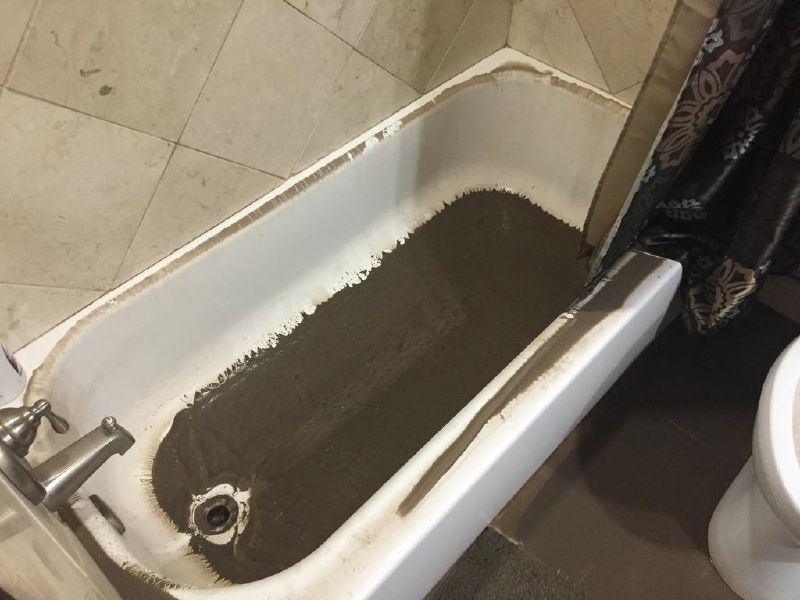My Guide to Sewage Emergence in the Bathtub
My Guide to Sewage Emergence in the Bathtub
Blog Article
Any individual is bound to have his or her own perception when it comes to Why is There Sewage Coming Up Through the Bathtub.

Sewer back-up in the bath tub can be a stressful and unsanitary problem for any home owner. Not just is it troublesome, yet it also presents major wellness risks and indicates underlying issues with the plumbing system. Understanding why sewage is turning up via the bath tub is critical for taking ideal activity to address the trouble effectively.
Introduction to the Problem
Recognizing the Problem
When sewer draws back up into the bathtub, it's a clear indication of a problem with the water drainage system. The wastewater that should be streaming far from your home is rather finding its way back right into your home, which can bring about significant damages and health hazards.
Possible Causes
Several factors can contribute to sewage back-up in the bathtub. From obstructions in the sewer line to concerns with the plumbing facilities, determining the source is essential for locating a service.
Typical Factors for Sewage Backup
Obstructions in the Sewage System Line
Among the most usual root causes of sewage backup is a clog in the drain line. This can occur because of the accumulation of particles, oil, or foreign items in the pipes, stopping proper flow and causing sewer to back up right into your bathtub.
Tree Origin Breach
Tree roots looking for wetness and nutrients can infiltrate sewer lines with tiny fractures or joints. Over time, these origins can expand and increase, causing considerable damages to the pipelines and resulting in sewage backup concerns.
Aging Facilities
Older homes might have outdated plumbing systems that are extra susceptible to corrosion, cracks, and wear and tear. As pipes age, they come to be much more vulnerable to leaks and blockages, increasing the probability of sewage backup cases.
Heavy Rainfall or Flooding
During periods of heavy rainfall or flooding, the drain system may end up being overloaded with excess water, causing backups and overflows. This can result in sewage supporting right into tubs and other fixtures inside the home.
Health And Wellness Dangers Related To Sewer Backup
Contamination of Water
Sewer back-up can infect the supply of water in your house, posturing a major health threat to you and your household. Direct exposure to polluted water can result in intestinal concerns, skin infections, and various other health problems.
Spread of Disease
Sewer includes hazardous germs, viruses, and parasites that can trigger a range of conditions, consisting of liver disease, cholera, and gastroenteritis. Entering into contact with sewer or contaminated surface areas places you in danger of infection.
Mold Growth
Moisture from sewer backup can create ideal conditions for mold and mildew growth in your house. Mold spores can worsen respiratory system troubles and trigger allergic reactions in sensitive people, making punctual clean-up vital.
Indications of Sewage Back-up
Foul Odors
Undesirable smells rising from drains or components, specifically in the restroom, may suggest sewage back-up problems. These odors are commonly solid and consistent, signifying a problem that calls for instant interest.
Slow Draining Fixtures
Bathtubs, sinks, and commodes that drain slowly or otherwise in all could be experiencing sewage back-up. If multiple components are affected simultaneously, it's most likely that the problem stems from a typical factor, such as the main sewage system line.
Gurgling Sounds
Strange gurgling or bubbling sounds coming from drains when water is running elsewhere in your home are a sign of air caught in the plumbing system. This air accumulation can result from sewage back-up and should be explored immediately.
Immediate Actions to Take
Shutting Off Water Supply
In case of sewer backup, it's necessary to switch off the water system to prevent further contamination and damages. Situate the main water shutoff valve in your house and shut it off till the problem can be fixed.
Contacting a Specialist Plumber
Taking care of sewage back-up is not a DIY task. Get in touch with a licensed plumber with experience in dealing with sewage-related problems to evaluate the circumstance and do necessary repair work or cleanups.
Preventing Contact with Infected Water
Till the sewer backup is fixed, stay clear of contact with polluted water to prevent the spread of bacteria and microorganisms. Wear protective equipment if you must remain in the damaged area and clean your hands thoroughly afterward.
Preventive Measures
Normal Maintenance of Drain Lines
Schedule routine inspections and upkeep of your drain lines to recognize and attend to potential concerns prior to they rise right into significant issues. This can consist of cleaning out particles, inspecting for tree origin intrusion, and fixing any kind of damaged pipelines.
Installing Bayou Shutoffs
Consider mounting bayou valves in your plumbing system to avoid sewer from receding into your home throughout durations of heavy rainfall or flooding. These shutoffs immediately close when water draws back up, securing your residential property from contamination.
Appropriate Disposal of Household Waste
Stay clear of purging anything besides toilet tissue and human waste down the bathroom to stop blockages and blockages in the sewage system line. Dispose of oil, oil, and various other home chemicals appropriately to minimize the risk of plumbing problems.
Tidying up After Sewer Back-up
Disinfection Procedures
Thoroughly disinfect and sterilize impacted areas after sewer backup to get rid of hazardous microorganisms and avoid mold and mildew growth. Use ideal cleaning items and protective equipment to make sure safe and efficient cleaning.
Repair of Affected Locations
Fix any kind of damages to floor covering, walls, or components caused by sewage back-up. Relying on the extent of the damage, you might require to replace carpets, drywall, or other materials to recover your home to its pre-loss condition.
What To Do If Sewage Starts Coming Up Through Your Bathtub
Sewage coming up through your bathtub is more than just gross. It poses a major health risk as sewage contains harmful bacteria and microorganisms that can be dangerous if exposed to them. While your tub or shower will certainly need a deep cleaning when this occurs, you’ll first need to get to the root of the issue.
If you notice sewage coming up through your bathtub, research Cherry Hill, NJ, licensed plumbers right away to get it fixed.
Why Sewage Is Coming Up Through Your Bathtub
The most common reason for sewage coming up through your bathtub is a clogged sewer line. All the sinks, toilets, and tubs connect to a single drain pipe that leads to the sewer line under your house. This drain line carries all wastewater and sewage away from your home to the city’s sewer system.
When the sewer line becomes clogged or blocked, wastewater has nowhere to go but back toward your house. This results in sewage coming up through your drains, often starting with your tub or shower.
The sewer line can become blocked by anything, but the most common culprits include:
Hair ? Cooking oils and grease ? Food waste ? Soap particles ? Children’s toys ? Jewelry ? Baby wipes or other non-flushable items ? Dirt ? Rocks ? Tree branches and debris ? Rodents How To Fix A Clogged Sewer Line
When you experience sewage coming up through your bathtub, it’s always best to contact a professional. Attempts to fix a clogged sewer line without experience often lead to more plumbing damage. However, you can try a few things that may loosen blockages in smaller connecting pipes.
Don’t Use A Plunger
Plungers only work to loosen obstructions near the head of the drain or toilet. It won’t be able to reach your sewer line or unclog the blockage.
Turn Off The Water
Turning the water off from the main valve will prevent excess water from flowing into already backed-up areas. This will also keep more sewage from coming up through your drains.
Check Your Vent Pipe
When vent pipes become clogged or blocked, it can lead to problems with the sewer line. By pulling any obstructions out of the pipe, your sewer line should be able to properly drain. The vent pipe can be located on your roof, usually directly over your bathroom.
Snake The Shower Drain And Toilet
Using a drain snake can help break up the object causing a blockage. By snaking both the shower drain and the toilet, you may be able to fix the issue. You’ll know you’re successful if the tub drains all sewage and wastewater.
Call A Professional
If these tactics don’t work, you will need to call a professional plumber. They will perform a camera sewer line inspection to find the source of the blockage and determine the best way to remove it. A professional will use a drain snake or conduct hydro jetting to unblock the sewer line and get things back in working condition.
If the obstacle blocking your drain line has caused any damage, you may also need your pipes repaired or even replaced.
Gurgling While Draining
Listen for gurgling sounds coming from the shower drain or sink, as this is an early warning sign of a clogged sewer line.
Frequent Clogs
If your toilet or other drains continuously become clogged, you need to call a professional to look at it. While you may be able to get the water or waste to drain again, it may only be a temporary fix.

Do you appreciate reading about Why is Sewage Backing Up Into My Bathtub?? Put feedback down the page. We would be happy to find out your thinking about this blog post. We hope to see you back again later on. You should take the opportunity to share this post if you liked it. Thanks a bunch for being here. Return soon.
Schedule Services
Report this page